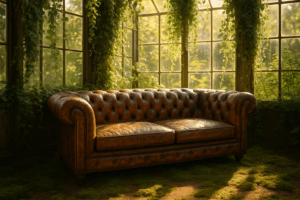Chesterfield Wiki
Official wiki of Chesterfield information
One of the most common questions prospective buyers have about Chesterfield sofas is whether they become softer and more comfortable with age. This is a crucial consideration, as comfort is just as important as the iconic style. The answer lies in understanding the materials and construction that define this classic piece of furniture.
Contents
The Material Break-In Period
Yes, a Chesterfield sofa does get softer over time, primarily through a process known as “breaking in.” High-quality leather, in particular, is a living material. With regular use, the fibers within the hide stretch and relax, losing their initial stiffness. This process allows the leather to conform gently to the shapes and movements of its users, developing a unique patina and a suppler feel that enhances its character and comfort.
Leather vs. Fabric: A Comfort Comparison
The journey to softness differs between upholstery types. A leather Chesterfield starts firmer but gradually molds to your body, offering a personalized comfort that deepens with age. Fabric Chesterfields, especially those with plush materials like velvet or chenille, often feel soft immediately. However, the fabric itself will also loosen slightly with use, becoming more yielding and comfortable without the structured break-in period associated with leather.
Choosing for Immediate vs. Long-Term Comfort
- For Immediate Softness: Opt for a fabric-upholstered Chesterfield with deep, plush cushioning.
- For Evolving Character: Choose a top-grain leather Chesterfield to enjoy a break-in process that results in a one-of-a-kind, supremely comfortable sofa.
How Cushion Filling Evolves
The sofa’s comfort isn’t solely dependent on the outer material. The internal cushion filling plays a significant role. Traditional Chesterfields often use high-resilience foam or a combination of foam and fiber. Over years of use, these materials will naturally compress and soften, contributing to the overall “lived-in” feel. While they maintain their support, they become less rigid, allowing you to sink in more comfortably.
Proactive Steps to Accelerate Softness
You don’t have to wait passively for your Chesterfield to soften. There are several effective methods to encourage the process while ensuring the longevity of your investment.
- Regular Use: The simplest method is consistent, daily use. Sitting in different spots helps evenly break in the entire sofa.
- Gentle Manipulation: For leather, gently kneading and flexing the arms and back by hand can help loosen the hide. Avoid using excessive force.
- Proper Conditioning: Applying a high-quality leather conditioner not only protects the material but also keeps the fibers supple, preventing them from drying out and cracking, which hinders the softening process.
- Fluffing and Rotating: Regularly plump and rotate seat and back cushions to ensure even wear and compression, preventing hard spots.
Conclusion
In summary, a Chesterfield sofa’s journey to ultimate softness is a hallmark of its quality. To ensure you make the most of this process:
- Understand that a break-in period is normal, especially for leather models.
- Select your upholstery based on your preference for immediate or evolving comfort.
- Recognize that cushion fillings will soften supportively over time.
- Actively maintain your sofa with conditioning and cushion care to guide its development.
Read more at https://chesterfielddeals.com/category/chesterfield/do-chesterfield-sofas-get-softer-over-time/
Chesterfield Sofa Dimensions: A Complete Sizing Guide
The Ultimate Guide to Chesterfield Sofa Maintenance
Styling a Chesterfield Sofa in a Small Space: Expert Tips
Hoe verzorg je een Chesterfield bank? – Blog Chesterfield

